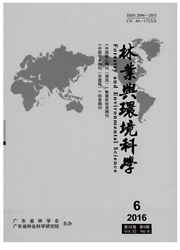

 中文摘要:
中文摘要:
采用Li-6400型光合作用仪,在晴天条件下对小桐子3个栽培品种(“湛江”、“攀枝花”和“印度”)的光合特性进行了比较,探究小桐子光合作用与相关生理生态因子的关系,以期为不同小桐子合理的栽培管理提供理论依据。结果表明:(1)不同品种小桐子净光合速率日最大值出现在中午11:30时;湛江小桐子、攀枝花小桐子和印度小桐子的最大净光合速率分别为36.4,22.3,33.4μmolCO2·m-2·s-1,平均净光合速率分别为17.4,14.3,15.7μmolCO2·m-2·s-1。(2)不同品种小桐子光合速率均受气温、二氧化碳浓度、气孔导度、蒸腾速率的共同作用。(3)在高温强光下湛江小桐子、印度小桐子的净光合速率和蒸腾速率都较高,是强光性植物;而攀枝花小桐子在光强改变时光合作用的变化较小,对光的适应性强。
 英文摘要:
英文摘要:
The photosynthetic characteristics of three cultivars (ZJ, PZH and IND) of the oil plant Jatropha curcas were compared to explore the relationship between physiological and ecological factors. The photosynthetic indexes of three cultivars were tested respectively by Li-6400 photosynthetic system in sunny days. The results showed that the diurnal variations of net photosynthetic rate (Pn) of the three cultivars all exhibited " single peak curve" which appeared at 11:30. The maximum Pn of ZJ, PZH and IND cultivar were 36.4, 22.3, 33.4 μmolCO2·m-2·s-1, respectively, and the average Pn were 17.4, 14.3 , 15.7 μmolCO2·m-2·s-1 , respectively. The photosynthesis of J. curcas was limited by atmospheric CO2 concentration, air temperature, stomatal conductance and transpiration rate. The ZJ and IND cultivars needed much more light than the PZH eultivar, which had wider adaptability for light.
 同期刊论文项目
同期刊论文项目
 同项目期刊论文
同项目期刊论文
 期刊信息
期刊信息
